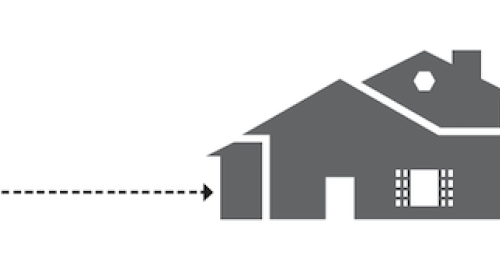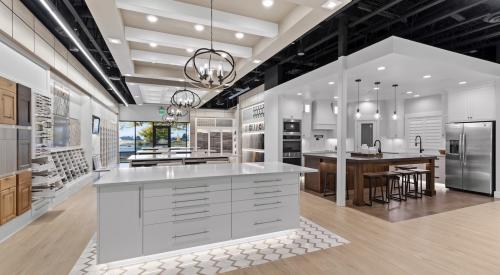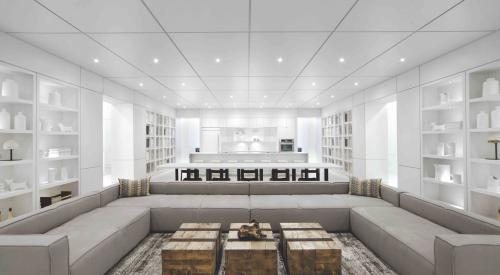The retail sensibility defines new home buyers as it has consumers of cars, clothes and appliances for years. New home buyers want something unique, and they feel they have earned the right to get it.
The tools to deliver on these desires: options and upgrades. These add-ons have been the builder’s gravy train — or so it seemed — as we bounded from the 1990s recession into prosperity and lower interest rates. Initially modest and manageable (a second selection in countertop or cabinet finish, mirrored wardrobe doors), new home finishing choices became fruitful and multiplied.
Today, even an entry-level buyer gazes at a big basket of goodies — a closet system here, high-tech wiring there, the chance to swap the den for an extra bedroom. Vendors offer more selections all the time.
More choices, more stuff, more fun buying homes was the promise, along with more profits and happier builders. But it’s not working out exactly that way.
Some builders call it “features creep” and question the value of options and upgrades. Builders with options programs grapple with new challenges, and those who didn’t jump on the bandwagon ask how to keep choice- hungry buyers fed.
While mindful of the pitfalls, many builders still see more benefits in developing a long list of extras to attract discriminating consumers. Choice, they say, means faster absorption, better brand distinction, more market share, happier customers, more referrals and enhanced profits.
That said, these benefits result only if buyers value the options and extras. Smart practitioners of the options-trading game start and stop with who they are and who their buyers are. Their approach to new home personalizing is based entirely on understanding their buyers and how their companies can best satisfy them. Keeping accurate tabs on the buyer is a basic, and the research methods are as individualized as the companies.
“Listening to the buyer and removing your own biases is the answer,” says Tom Gillespie, vice president of housing for Kennedy Homes in East Dundee, Ill.
Gillespie says that determining what is included and what is an option (for production homes of about $190,000 to $240,000 base prices in the Chicagoland market) is rather simple. “Typically, we see builders creating inclusions based on what the guy down the street is offering. That’s great if he is the one using research, but I’ll guarantee you he isn’t, so you end up with an entire market of builders adding more and more to their homes based on the competition and what they personally like in a home. At the end of the day you have forced your buyer to accept a bunch of things that they give you no credit for, and you are either working on low margins or being priced out of the market. I believe they call that insanity. The best outcome is determined by what the buyer wants. Period.”
Keller Homes in Colorado Springs, Colo., a leader in the stand-alone design center, adds vendor tips to its research mix. “Our vendors tell us a lot about what people are buying,” vice president Pam Keller says. “We also depend on our merchandiser, CDA, to bring us the trends from the West Coast. Being first with the latest is part of our brand.”
| Its West Coast merchandiser and various vendors help Keller Homes of Colorado Springs, Colo., identify trends and hot items, and then the company chooses options that suit its buyers and market. |
Keller adds that the “wow” factor is not enough. “The product has to work, it has to make the customer’s life better, and it needs a shelf life of up to two years before my competitors begin using it. You can look at your own life for some of the hot buttons, like low-maintenance aluminum windows, for instance.”
“Real estate is local. Research your home market first,” counsels Roger Mankedick, executive vice president of sales and marketing for Palatine, Ill.-based Concord Homes, which serves a wide range of prices and housing types in suburban Chicago. “We use an internal marketing department. They are very talented and have been groomed for this work. All of us know we have to live and die with the results of our research. We want to make sure we know what we are doing, and an internal department has proved best for us.”
| Pardee Homes in Southern California and Las Vegas tracks buyers’ choices in current Pardee homes and applies that information to new models targeted to the same buyer group. |
At Pardee Homes, a Los Angeles-based builder/developer that serves diverse move-up markets in Southern California and the Las Vegas area, “We use focus groups, and we study outside research, but we depend most on what our buyers tell us,” says Joyce Mason, vice president of marketing. “We are lucky to be high enough volume to have previous product aimed at similar buyers. We track what is chosen, what isn’t and what the requests are.”
Kennedy Homes relies on exhaustive surveys, conducted and analyzed with a combination of internal and external sources. “Annually we survey up to 10,000 buyers, asking questions that tell us exactly what they want,” Gillespie says.
SeaCountry Homes in Newport Beach, Calif., listens carefully to women. Its interior merchandiser is Lana Canova of Design Tec, and SeaCountry president Buck Bennett says she brings affordability and retail input to spec discussions. A woman heads SeaCountry’s purchasing department, and another runs the sales and marketing end. “Women buy the homes,” Bennett says. “We’re trying to learn what they want.”
Maracay Homes of Scottsdale, Ariz., has tapped into American Lives, a San Francisco research firm that helped Maracay identify housing types and lifestyles in the Phoenix market. Internalizing such psychographic profiles as Heartlanders, Cultural Creatives and Moderns (American Lives partner Paul H. Ray co-authored a detailed look at one in The Cultural Creatives), Maracay redirected its way of doing business. “It’s helped us move away from the typical builder’s style,” president David Bessey says. “Our model presentations and plan alternates speak to each profile. For instance, the Modern will take the master bedroom retreat, while the Heartlander will choose an enhanced family area.”
Brand ID
Thus, questions about what to include and what to option are not questions about materials. The materials are answers that come fairly readily if you know what you are producing and for whom.
“We were competing on price in 1989, with the same plans, a few options and a few color selections,” Keller says. “It was a bad time, and we decided to find a way to differentiate ourselves from the competition. Choice was the answer.”
| Builders can differentiate their companies by identifying a niche and creating a brand around it. McStain Neighborhoods in Boulder, Colo., markets and builds environmentally sensitive, energy-efficient homes. |
McStain Neighborhoods of Boulder, Colo., positions itself as green. Jeff Kingsbury, vice president of sales and marketing, says this means more than environmentally sensitive products. “We want to build a more durable, healthier, environmentally sound home that makes economic sense and offers premium quality,” he says. “We are working to make sure the choices we offer and the systems we establish support this philosophy.”
A niche of successful projects in prestigious locations is the hallmark of Neal Custom Homes in Bradenton, Fla. “We like to think of our homes as ‘jewel boxes’ in amenitized communities,” says Leisa Weintraub, marketing vice president. “Our homes tend to be 1,700 to 2,500 square feet with many options, and most are in country club communities.”
At SeaCountry, which built 200 homes last year in Southern California, “We position ourselves as the bed-and-breakfast company in a chain hotel world,” Bennett says. “Personalizing is central to this message. We pride ourselves on being a home marketing company, not a home building company. Building is a product of selling, not the reverse. This creates a different attitude. It makes us different from companies that are dictated to by their construction departments.”
Builders such as SeaCountry led the way in home customizing, says Mason. “Buyer ability to personalize gave smaller companies a very important niche as part of their value proposition,” she says. “When larger builders saw the response and the profit potential, they began to adapt their organizations accordingly.”
Methodologies
“Everyone wants to personalize their interiors, and they want to live where the land plan and the exteriors create value for their investment,” Mankedick says. “The market knows what it wants, and that is a value equation.” He agrees that delivering on these desires has complicated things. “If you’re not complicated today, you’re out of business.”
So, how to meet the challenge of meshing buyer desire with what you can realistically provide?
Concord offers three levels of standards and options, tied to price ranges that go from $100,000 to $1 million, in housing types that range from single-family detached to high-rise condominiums. It permits some framing and foundation changes at each level, with the top tier of semi-custom assistance termed “Katy bar the door” by Mankedick. At all levels, Concord offers several plan choices, plus three to four hours of “sit time” with the architect of record, after a pre-construction meeting collects basics on wants, wishes and cost limits.
One especially successful Concord product is a mews design that features courtyards, rear auto courts and three-level units. Created in 1996 by Concord and its architectural firm, Bloodgood Sharp Buster, it offers great elasticity with about 15 floor-plan changes, all rising from a uniform foundation template. “We can get the concrete out in front of final decisions before winter sets in,” Mankedick says. “Buyers at even the lowest price points want some opportunities, and the mews provides this.” Concord has sold some 1,200 of these units and continues to refine the possibilities.
Also working with Bloodgood Sharp Buster, Maracay has taken flex design to a new level. Maracay offers homes with as many as 20 flexes. Structural revisions can be significant but usually do not involve load-bearing walls. “We looked for something different, and flex is it,” Bessey says.
The Other Guy
With Lennar’s “Everything’s Included” program, buyers won’t see a long list of alternatives. They will find a sound marriage of style and function, with the quality of included elements as strong a part of the message as the simplicity of the process in acquiring them. Some question E.I. Others applaud.
“Lennar has cut across price ranges and spoken to every single person who is struggling with a time deficit,” says Sandra Kulli of Kulli Marketing in Malibu, Calif. “Their program is very appealing to younger buyers who don’t know whether they are ‘country’ or ‘urban.’ Lennar has done a very good job of providing quality with some limited choices most builders think of as upgrades, such as granite countertops. They have simplified an anxiety-producing process and removed the insecurity so many of us feel about making design choices. It’s not for everybody, but who needs everybody? You only need the buyers you’re aiming for, and Lennar is offering a less stressful approach that is very attractive to a significant part of the market.”
“This is what works for them,” Bennett adds. “More important is the fact that they have communicated the program very clearly. They are a great example of a departure from the standard way of selling. Simplicity is a very good teaching and communication tool.”
SeaCountry is simplifying, too, reducing choice categories and bracketing “solutions.” At Stallion’s Crossing in San Diego, buyers find “Home Organization Solutions” “Décor Solutions,” “Energy Solutions” and “Noise Reduction Solutions.” Each lists an array of included features and optional possibilities.
Even for Lennar, striking the balance of choice and simplicity is ongoing. Consider Murrieta, Calif., a fast-growing new home market in the Inland Empire region east of Los Angeles. Lennar builder U.S. Home, well-established in this market, and newcomer Lennar of Orange County soon will launch two new communities simultaneously with a “dual-platform” strategy. Denise Hayes, director of marketing for Lennar in Orange County, explains:
“We’re committed to E.I. It’s a proven way to achieve optimal construction efficiency, support our zero-defects goals and keep the process simple for the buyers Sandra Kulli describes. But Murrieta is a very mixed bag of young families, affluent families and empty nesters, and U.S. Home has been here for a long time, with a design studio approach. We don’t want to compete with our own company, so the Lennar line will be E.I., and U.S. Home will continue with its comprehensive options and upgrades program. The strategy is about market share, and it’s a first for Lennar’s Southwest region.”
Choosing Right
“We look for opportunities where an option has a very high value compared to cost,” McStain’s Kingsbury says. “We spend time and attention on what authentic architecture means. If we have a Craftsman exterior, how do we move this into the interior for millwork, plumbing and hardware?”
At Pardee, “We strive for a standard package that will hold its own as a value statement,” Mason says. “We build from that, adding possibilities for buyers who want to do more. Buyers see standards and upgrades mixed in our models, and they understand that the standard package is a very solid choice to make.”
Pardee scrutinizes proposed additions to standards and options for availability, warranty and ease of incorporation. “Spectrally selective glass is a great example,” says Mason. “It’s a choice that resonates at every price, and it’s cost-prohibitive for the buyer to add later.”
Pardee also exercises caution. “We can’t compete on price with Home Depot or Circuit City for appliances and TVs,” Mason says. “So for kitchen and theater packages, we tend to stick with what’s behind the wall, with upgraded exhaust, wiring and speakers. In some markets, our buyers can get help from local experts for planning these choices and installations.”
At SeaCountry, “We’re not the Rolls-Royce for our buyers, but we might be the Lexus or Infiniti,” Bennett says. “We aim for what we term ‘sensible luxury.’ An example is dual shower heads. Our focus groups came through loud and clear on these, and we include them at far lower cost than a buyer can do after the sale. They are perceived as very high-end, and our buyers are thrilled to find that we listened to their input.”
Managing Right
Structure is king, all say. Minimizing buyer confusion (and irritation) and maximizing the production process are the goals. “Our buyers follow a path in the design center that reflects their lifestyle, their pocketbook and their priorities,” Keller says. “We don’t care whether they buy upgrades, but we do care whether they understand the opportunities and have a chance to make an informed decision.”
Precision is vital. “Flex is not customization,” Bessey emphasizes. “It’s pre-designed, pre-engineered, pre-approved by the city and pre-priced. It has limits, but it goes much further than typical production changes.”
Teamwork, from the start, is important. “We look to our architect and interior merchandisers to tell us what’s new and hot in the market,” Weintraub says. “It’s important to be on top of trends. Purchasing tells us whether we can afford it, whether the buyers can afford it, and construction tells us if they can duplicate the details at reasonable cost. We carefully evaluate certain options to determine if they add impact but not too much to the price.”
Concord began a purchase order system in 1992 for 92 homes and last year closed 1,242 homes. “As the evolution continues, we’ve asked our operations department, our contracting department and our architects to morph into different types of operations,” Mankedick says. “You have to hire and bring on new and different types of skill levels to make all of this work. We aim for flexibility so we can capitalize on the opportunities we seek and find in various marketplaces.
“With the added overhead, you have to make sure you understand what and why you are doing things. You charge for it while you are establishing systems that make the customer happy and also make you happy in terms of the bottom line.”
| Firm limits and communication among designers, purchasing and sales keep Standard Pacific in control of options. |
Standard Pacific anticipates snags with full-time decorators, selection rooms, an in-house architect and a purchasing department employee who is the designated coordinator and cost shopper. The company sets clear boundaries. “We are semi-custom, not custom builders, and if something looks like a warranty nightmare or too costly to the buyer, we will not allow the change,” says Judy Mason, vice president of marketing for the Texas division, which offers move-up and move-over homes in Houston, Dallas and Austin. “We watch for options and changes that might price the house out of the market, create an appraisal problem or delay delivery. We make sure our salespeople are experienced. They know what we will and will not do.”
Working with subcontractors and suppliers can be challenging, Bessey says. “Our trade partners aren’t necessarily thrilled with flex designs because they are harder to build than a straightforward home,” he says. “But many of our subs and suppliers are helping us make improvements. “
Worth It?
Yes.
“Before we brought options and upgrades to our homes in Houston, we sold and closed 56 homes in six communities here,” says Mason of Standard Pacific. “In 2001, with the extras available, we sold 124 homes in six communities for our ‘build on your lot’ program, all homes of over $300,000. If we don’t offer changes and options in Texas, our buyer will go see the builders down the road because they will.”
Pardee’s Mason is also unequivocal. “The ultimate yardstick for any builder is sales,” she says. “When we show options and upgrades, we make more sales and faster sales. And when markets are shifting downward, our options program helps us keep our sales pace strong and steady. Options and upgrades are absolutely worth the challenges they present.”
A good options program also has a subtler side, says Linda Mamet, SeaCountry’s vice president of marketing. “It’s not unusual for one of our buyers to add $100,000 in structural options and finish amenities, yet if we priced the house at $800,000, this buyer might not even come to the door,” she says. “Options and upgrades help us appeal to a wider market. People shop with a purchase figure in mind, and they are happy to add from there as long as it’s their choice and decision process, not ours.”
At Concord, “Holding the same profit margins from year to year, we saw a 26% increase in extras and custom changes sold on a per-house basis from 2000 to 2001,” Mankedick says. “Buyers are happier because we are allowing them to have their budget say yes or no instead of us. And 86% of our custom quote requests are accepted by the buyer after pricing.”
Others see their options program as a smart part of their way of doing business. “Adding to our bottom line is not our primary goal,” Keller says. “People still buy on emotion, and when they can see the things they want in a home, that’s important in their decision to buy.”
Kennedy’s Gillespie agrees. “We do not view our design center as a profit center, and it’s difficult to directly measure any increase in profit or sales. It isn’t about selling options and upgrades, but about satisfying the buyer. Our design center yields a profit because people buy things, but we measure it not as a profit center but against the total gross margin for the lot. The design center is not the driver of profit; our entire systems approach to home building is.”
At Maracay, “The year we introduced our flex program, our sales doubled,” Bessey says. “I do know from our research that buyers want choice, and our flex designs give them that at reasonable cost. The brand separates us completely, which is very important in a market like Phoenix, which saw some 36,000 new home permits last year.”
Keller summarizes: “I wouldn’t sell any houses if I went backward. This is who the consumer is; I’m one of them, and I want choice, quality and service.”












